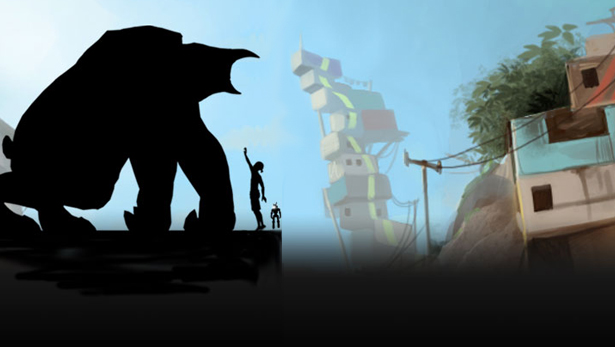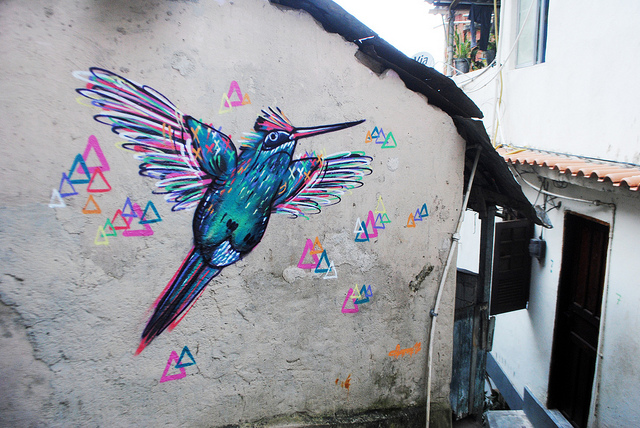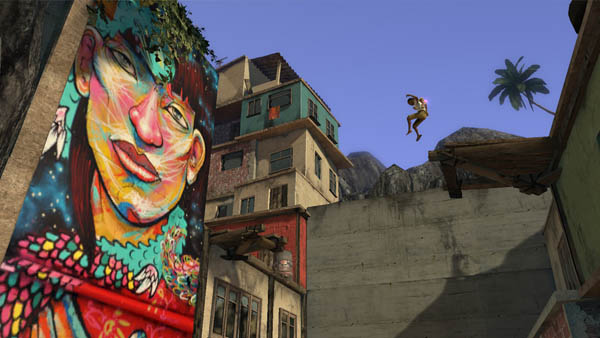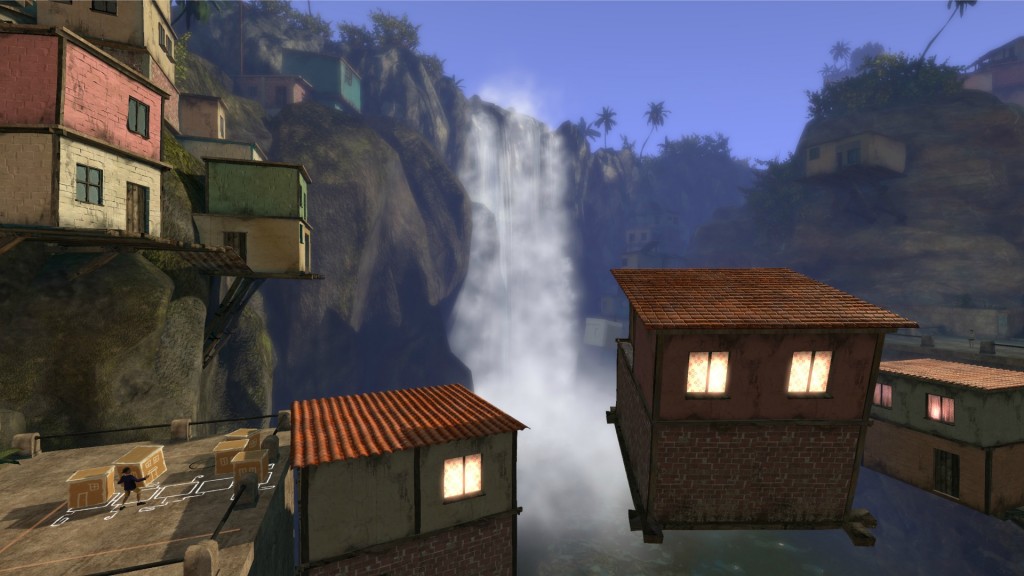In video games, there are trends to be tracked and bandwagons to be jumped on, but prognostication is still nearly impossible. Will a game end up being influential in the long term, or will it join the ranks of obscure critical darlings and forgotten gems? Among such recent releases, and one I personally hope has an impact that lasts beyond the few initial weeks of press coverage, is Papo & Yo ($14,99; Minority Media for PlayStation Network). While the gameplay may be fairly conventional, perhaps even mediocre from a certain point-of-view, Papo & Yo represents a step forward for games as a legitimate medium for expression.
When debating whether videogames can be considered art, it’s become axiomatic that gaming has yet to produce its Citizen Kane, and that the medium is still growing through its cave painting/slapstick musical/penny dreadful phase. Not that I’m saying Papo & Yo is that game. What I am saying is that, when future gaming scholars – of course there will be gaming scholars – track the evolution of games from craft to high art, this game deserves a place on that family tree.
This isn’t a review; it is, in fact, a little late for one, with the game having been commercially available for quite a while now. If you’re interested in reading about gameplay, graphics, animation, and technical issues, take your pick. The existing body of reviews is also a great resource for those who want to find out about the basics of Papo & Yo‘s unique narrative in a spoiler-free way, because herein lie spoilers, speculation, and speechifying.
Papo & Yo‘s strength and potential lasting influence rest on three major pillars. The first, and the one that has everyone talking, is the Story, which is harrowing and personal in a way that is unprecedented in gaming. The second pillar, often overlooked in reviews as mere set dressing, is the sense of Place, evoked by a specific location, music, art design, and point-of-view. Finally, much of the game’s impact comes from not only presenting this story in an interactive medium, but from the choices made by the designers as to where and how the player’s Agency moves the narrative forward.
The First Pillar: Story
Papo & Yo is the story of a boy named Quico on a journey through a strange, magical world, trying valiantly to save his brutish, dangerous, but lovable pink friend Monster; it is the story of how Quico copes with the horror and fear of living with an alcoholic father by escaping into his imagination, where he has some semblance of power and control; it is also the story of how lead designer Vander Caballero learned to face the harsh reality of addiction, grew up, and ultimately built a new life. (Here’s a detailed synopsis of the major events of the game.)
Having a narrative that works on multiple levels and signifies various things through metaphor may be old hat for other forms of media, but it is a relatively unique notion in a videogame. Game stories are usually “about” something, e.g. boy meets girl, boy loses girl to turtle-dragon thing, boy gets girl, girl bakes cake. That isn’t to say that game narratives don’t get more complex; some of the finest have delved into levels of intrigue that would put Game of Thrones to shame, or have touched on universal themes with stories of loss and redemption. Still, what you see is often what you get. Take, for instance, the Metal Gear series and the overarching narrative about how Cold War interventionism led to a world of perpetual warfare driven by private military corporations. It is, well, a polemic about how Cold War interventionism led to a world of perpetual warfare driven by private military corporations.
Papo & Yo, however, wears its multiple meanings on its sleeve. The imaginary world of the game is an explicit metaphor for the real world that Quico inhabits. In fact, much of the power of the ending sequence comes from the artifice being forcibly torn away, only to reveal the ugly, but ultimately liberating, truth. Even without the long run-up of interviews and blog posts from lead creator Caballero, stating that the game is his story, it is still fairly clear that Papo & Yo is at least in part autobiographical. The game actually begins with a dedication that ties directly into the story, with childlike block letters on a black screen reading: “To my mother, brothers, and sisters, with whom I survived the monster of my father. – Vander Caballero.”
It could be argued that the whole enterprise is, in narrative terms, fairly amateurish. After all, once you spell out the detailed intent in your work, it stops being subtext and becomes text. But this is a medium that is, in many ways, still in its infancy; it’s figuring out what it can and can’t do, and we cannot expect that gaming’s very first “memoir” (for lack of a better term) be a virtuoso performance right out of the gate. Our knowledge of what the gameplay stands in for can give more impact to certain moments than if we were to merely take them at face value. As gamers, we are asked – conditioned, even – to suspend our disbelief to an extent unmatched by any other form of media. We accept an incredible degree of surrealism simply because games have never had to make sense to be fun: they just need an internally consistent rule set. So, when it comes to Papo & Yo, it would be easy to take the morphing game world, with its double-jump-enabling robot and rage-inducing frogs, for what they are, rather than for what they mean. As a result, it’s not a bad idea on the part of a developer to walk us through the symbology of the their word, without spelling everything out.
In effect, we are spoon fed part of the story, putting us in the mindset for understanding the symbols used throughout Papo & Yo. We are then left to construct the rest of the narrative through the environments and character behavior. From the get-go, Monster is explicitly stated to be Quico’s father, and the “Shaman” refers to itself as Quico’s incipient adulthood, but Lula and Alejandra remain a little more mysterious. Lula defines itself as a mother figure purely through action and the character arc; as for Alejandra, we’re never quite sure if she is meant to be a friend, a sister, a first love, or an element of Quico’s psyche. Then, as the world begins to lose its coherence toward the end of the game, there is the implication that the fiction used by Quico as a coping mechanism is falling apart, to be replaced by harsh truth.
In order for the medium to truly evolve, I believe that the first major step video games need to take is to find ways to make games not just enjoyable but meaningful. Just as film isn’t a lesser medium for churning out fun, fast-paced blockbusters and gross-out comedies, as well as taut dramas and emotionally raw independent films, there is room in games to provide both the traditional reflex-based experience and to explore deeper, possibly more difficult and unpleasant themes. The interactive nature of the narrative shouldn’t preclude creators from evoking a specific emotion, or guiding the player to a particular conclusion.
Gaming would need to go beyond the standard fantasy, sci-fi, or crime narratives, and into stories that have a greater focus on both interpersonal relationships and internal psychology. It doesn’t just have to be about novelty and escape. There’s an untapped potential to shed light on unfamiliar aspects of the human experience and provide new perspectives to gamers about their own lives. The nature of videogames is to be both a form of play and a medium in which anything can happen, which is why I feel the new kind of gaming experience would most likely lean heavily on metaphor and symbolism. In this regard, Papo & Yo‘s use of characters, environments and gameplay elements as proxies for emotional and psychological states is an excellent example of how it can be done.
The Second Pillar: Place
One of the more remarkable (and barely discussed in reviews) aspects of Papo & Yo is the vivid and specific sense of place evoked by the game’s art and musical direction. The setting for the game is a dreamlike – but still very much reflective of reality – version of a Brazilian favela, a chaotic shantytown of small, colorful homes spilling down the sides of vibrantly green mountains in haphazard waves, seemingly defying physical laws.
As Quico begins to explore this new world, music swells in layers: percussion of conga drums, then maracas, building into an acoustic guitar melody accompanied by lilting flutes and cheerful vocals. The environments are bright and colorful, with a very strong sense of the daytime interplay of light and shadow. Children’s toys lay on rooftops and in corners; green clearings wait patiently for a fútbol match between the neighborhood children. But the favelas themselves, though brightly painted, are textured to show the wear and tear of time and poverty. Corrugated tin roofs, pitted with rust, and water-stained wooden planks form the paths taken by the main character; laundry hangs from lines; homes are stacked chaotically upon each other.
Papo & Yo is one of the few games that I’ve encountered with a distinct, authentic Latin American flavor in its world, something that struck me from the get-go. There have been a number of games set in Mexico and South America, such as Grim Fandango, Red Dead Redemption, and Max Paine 3, all excellent games in their own right. However, they are clearly the result of designers looking at a culture from the outside in. There is a tendency in Western media to rely on broad signifiers, stereotypes, and facile iconography in order to portray areas of the third world. (Mexico is a place of deserts and Day of the Dead parades; Brazil is Carnivale and glamorous drug lords; Columbia is jungles and narco-mansions.) The sense of place and culture in Papo & Yo is more subtle and lived-in, and thus more real. While there may be quite a bit of repetition among the narrow, brightly painted alleys, the game transports the player with ease and grace.
Like the game’s story, the setting is a direct result of Caballero’s own experiences. In a pre-release interview, he told Joystiq, “I was thinking about the setting at the beginning and I went through many different settings. But what I realized in the end is you can only talk about what you know. And when you talk about what you know, people want to believe you. So suddenly I realized I knew [I wanted it set in a favela] and I knew how to take people there; how to bring people there in an attentive way. I come from South America, so I can bring players to that. If I had picked another setting, it would’ve felt fake and people would’ve felt it. Everything is about making the game authentic.”
Caballero’s focus on painting a true, if not necessarily realistic, picture of the world he grew up in extended to his artistic collaborators as well. Turn almost any corner in the surreal cityscape of Papo & Yo and you’re likely to encounter a massive, vibrant graffiti mural of a fantastical tropical bird, an elaborate carnivale mask, or an ethereal, beautiful woman. The images are startling in their artistry and vibrancy, but what’s even more remarkable is that every piece of graffiti in the game is an actual, licensed work from South American street artists, curated by Chilean-born author and documentarian Pablo Aravena. Aravena worked with artists Charquipunk (Sebastián Navarro), La Robot de Madera (Simón Paulo Arancibia Guttierez), and INTI (Inti Castro) to help ensure that the environments in Papo & Yo would recall South America not just in terms of architecture and the player’s immediate surroundings, but in atmosphere as well. Caballero had very specific intent for choosing this route: “In my development career, I have never worked with authentic artists from the game’s locale. The project’s art director is usually instructed to mimic what he can find from reference pictures. But in Papo & Yo, I didn’t want to do the same thing. I wanted it to be genuine. And I wanted local artists on the other side of the continent to have access to the beautiful canvas of video games.”
Also crucial is the sound design work by Montreal-based sound studio La Hacienda Creative and its founder, Brian D’Oliveira. Much like Caballero, the Venezuelan-born sound designer and composer D’Oliveira was intimately familiar with the world that the game evokes. This familiarity led to an almost obsessive drive for authenticity. D’Olivera says of his time spent sourcing the sound design, “I’m from there too — I grew up in the Andes mountains of Venezuela — and it’s funny, because it looks just like the game. There’s a certain commonality — if you go to a favela in Brazil or a favela in Venezuela, there are similarities. For example, even tin roofs: I spent weeks trying to get the correct sound a tin roof makes. My assistants would bring in sheets of metal, and it wouldn’t be the right sound. You know the clay tiles on the roofs in the game? No one knows that sound here. I had to have them shipped from Texas, and when you step on them it creates that sound, it’s all authentic.”
Rather than relying on synths and a MIDI library, D’Olivera insisted on creating music from thirty-odd real instruments, some custom-built in order to create more fantastical sounds, and others deeply steeped in South American tradition. He even went so far as to purchase handmade hunting whistles from the Brazilian Amazon. In order to lay down percussion tracks, he says, “I had my teacher Vovo, a master Brazilian percussionist, perform. He’s almost 60 years old, he knows every possible Brazilian rhythm as well as Cuban, and he even went to Africa. So even the rhythms in the game, they all have roots.”
If it seems as though Vander Caballero and the team at Minority Media were obsessed with creating a very specific sense of place, it’s because they were. While the story of Papo & Yo is built primarily on metaphor, it’s still very much the story of one particular person’s childhood. As such, it benefits storytelling through a very honest, heartfelt milieu reflective of that childhood. While it’s been famously noted that renowned videogame creator Shigeru Miyamoto based the fantastical Legend of Zelda in part on his childhood explorations of the Kyoto countryside, a story like Papo & Yo could not work without a definitive grounding in reality. Without the environmental ties to the real world, the metaphors within the game would have required greater explanation of their meaning, potentially making the darker elements of the story seem wildly out-of-place. Additionally, one of the major themes of the game is that the power of imagination helps us build on the real world, making it a better, more tolerable place. This theme would be lost if the game did not provide players with a baseline version of reality to be manipulated.
A sense of place, as it turns out, is not just a matter of level layouts and architecture on which to build puzzle elements and scripted events. As in other forms of media, the objective is (or should be) for the setting to feel real and organic, with individual elements coming together in a way that gives the impression of a greater world that exists beyond the small sliver we’re shown. With Papo & Yo, an exhaustive recreation of cultural signifiers helps realize this objective by involving people steeped in that culture through their own experience.
What does this mean for videogame world building as a whole? In part, it explains why so many games feature settings that tend to be either American or Japanese, both in culture and point of view. We create based on what we know and have experienced, but it goes further than that. Most American gamers are familiar with the strange, fun house version of the US that appears in the Scottish-designed Grand Theft Auto, or the generically, implausibly white-bread Midwestern cities of the Japanese-developed Resident Evil or Silent Hill (before the zombies, of course). For an American playing these games, there’s a strange sense of dissonance, with the games getting the details mostly right, but still feeling a little off. Similarly, it’s often laughable when American developers attempt to make use of Japanese/pan-Asian culture or settings in their games, mashing up the details with gleeful abandon (see, for example Mortal Kombat, or, really, anything featuring ninjas). America and Japan are the two nations with, more or less, a cultural hegemony over game development. As far as most first-world game developers are concerned, South America, Africa, and most of Asia exist mainly to provide antagonists with AK-47s and heavy accents. We are often on the outside looking in, when we could be on journeys guided by those who have lived in these places and know them intimately.
Papo & Yo is not a strict documentary of growing up in a Brazilian favela, and it uses the cultural point of view to build a fantasy world that hearkens back to the real world. To some extent, this is what nearly all fantastical game settings do. For example, most Western fantasy games draw on a common pool of imagery based in Dark and Middle Ages of Northern Europe. Some settings, in fact, can get terribly specific, like the very Scandanavian tundra and fjords of Skyrim. Japanese games, meanwhile, have a similar tradition of pulling from their history, mythology and iconography when creating fantasy worlds. Papo & Yo provides players with an expanded cultural point of view and an authentically different world to play in. Experiencing something new and novel is one of the main pleasures of gaming, and the medium as a whole can benefit from elevating voices that depart from what most gamers are used to.
The Third Pillar: Agency
When Quico turns a corner in this new-yet-familiar world and first spots his guide, Alejandra, she is an immediately intriguing figure. She navigates the streets and rooftops with preternatural speed, vanishing suddenly, then appearing a hundred yards away. Where her natural agility isn’t enough, she is able to bend the city to her will by drawing on the ground and the walls in chalk. Swirling designs and lines glow white with power, as she sketches doors, gears, keys, and levers. The items that Alejandra and, in short order, Quico interact with are limited only by her imagination. Through the magic of play, she creates new paths, opens doors, and makes buildings move to accommodate the adventure.
With children’s drawings serving as a means of interaction and transformation, this detail underscores one of the major driving ideas behind Papo & Yo: imagination is a powerful force in people’s lives, especially for the young. Quico, like Caballero and so many of us, learned to cope with frightening circumstances by escaping into an inner world where he could exercise control and shape his fate. The fact that Papo & Yo takes the form of a video game is, in a way, a further expression of one of the central themes of the story. Quico’s journey is as much about control as escape. This is one of the major strengths of videogames as a medium, allowing players to not only enter a new world but also enjoy the sense of having an effect on the environment. Caballero notes, “When I was a kid and going through difficult times, games actually saved me. It was the only space where I could be in control and… experience safety, and predictability in a way. Everything outside was crazy.”
Over the past several years, much has been made of the unique potential games have as a vehicle for storytelling, beyond the movie-like cinematic sequences that play at key moments. Generally speaking, the more focused the game’s narrative, the less the player’s freedom. That doesn’t mean that complex or thematically deep narratives like Papo & Yo have to be told through dialogue and movie sequences only. As a matter of fact, while these scenes might be useful for setting and telling a story, they don’t take advantage of the greatest strength of games: player agency. The best game narratives use the player’s actions to service the story, and Papo & Yo makes use of a few such techniques, in addition to the more traditional pre-scripted cinematics.
For example, a developer may provide players with a totally open and minimally structured world, essentially inviting them to customize the environment and build their own narratives. This philosophy underscores games as diverse as Red Dead Redemption, Skyrim and Minecraft. Red Dead Redemption has a definite narrative through line, but gives players a vast world filled with distractions between point A and point B, from high-noon gunfights to Bigfoot. Skyrim, while still having something of a central narrative, is almost entirely built on searching out every last nook and cranny in the game world, from the deepest catacomb to the highest glacial peak, with some flower-picking and butterfly catching thrown in for good measure. On the furthest end of this spectrum lies Minecraft, where players are left in a world with literally no goal, and no sense of the rules and mechanics underlying the world. This could be regarded as the purest, most distilled form of player agency in videogames, as the player is encouraged to take the tools they are given to tell their own story. The disadvantage to this narrative technique is that it makes it difficult for the story to evoke anything beyond the broadest themes.
The nature of Papo & Yo doesn’t allow for too much in the way of emergent narrative. However, players are offered a small amount of freedom to explore and develop a deeper understanding of the story. In quieter moments, it’s possible to toss a soccer ball back and forth with Monster, to send him off to fetch a coconut, or to hop on his belly as he sleeps. While these moments are few, and the mechanics serve a definite gameplay purpose, taking time to play with Monster deepens the player’s relationship with him and casts a different light on Quico’s relationship with his father figure, making his violent betrayals that much more devastating.
A more focused gameplay-as-narrative technique uses environmental design and the world itself to further the story. While the bare bones of the plot are made obvious through cut-scenes or dialogue, the player is tasked with fleshing out the narrative by playing detective, using discovered notes, interactions between non-player-characters, and various level features (graffiti on a wall, an empty room arranged just-so, et cetera). This technique requires that the world be more constrained, with every object serving a definite purpose to the story. Given the level of observation required by this approach, it’s not surprising that the best examples of environmental narrative are delivered from the first-person perspective. Games like Half-Life, Portal and Bioshock drop players in dystopian, apocalyptic scenarios with very little in the way of concrete explanation. Clues are then used in these environments to tell how each of these worlds met their doom. Bioshock, for instance, uses this method to reveal how the residents of an Objectivist paradise, led by a John Galt-like leader, willingly became inhuman monsters and brought their city down around them in their thirst for power. Elements like defaced propaganda posters for competing factions and crumbling Art Deco architecture come together with clarity to paint the picture of a society that tore itself apart. In some ways, they even make superfluous the sections of the game where the player is simply told what happened.
The environmental details in Papo & Yo are effectively used to evoke a sense of place, within which we learn quite a bit about Quico and his relationship with his father. However, the most affecting moments in the game are in those situations where the designers present the illusion of choice. Essentially, the idea is to guide the player along a predetermined path, where only one course of action will move the narrative forward. This has to be done properly, without railroading the player and still allowing active participation in the game. One approach is to put the player on the path, but give only the slightest inkling of how to reach the next goal; the other way is to use set dressing to give the impression that the path is still part of a larger world. This approach can be best seen in two beloved PS2 games, Ico and Shadow of the Colossus, designed by Fumito Ueda and Team ICO. Each game presents the player with what at first looks like a massive, open world: an imposing castle in the case of Ico, and a terrain of wilderness and ruins in Shadow of the Colossus. However, the size of these worlds belies the fact that there is really only one method of advancement at any given time. In Ico, very specific sequences of jumps, switch pulling, ledge climbing and block moving must be executed with care. In SotC, the way forward is to watch for specific patterns in the movements of the enemy Colossi, in order to exploit their weaknesses. SotC is a master class in using this technique to evoke particular emotions in the player: the camera angles highlight the great odds against the player, the music swells as the player climbs onto the creatures, and every moment of the battle seems hard won. The true emotional punch is reserved for the victory, when aged stonework crumbles off the fallen Colossi to a mournful chorus, and the player suddenly has the sense that they’ve destroyed something very old, the likes of which the world would never see again. In a few ways, Papo & Yo is a direct descendant of these two games.
After Monster has killed Lula, Quico is tasked with luring Monster into a trap in order to extract energy intended to be used in reviving the little robot. In gameplay terms, this means that the player uses Monster’s much-loved coconuts to lead him into an inescapable pit, taking advantage of his hunger and his trust. Once Monster is captured, the player is tasked with springing the trap, cutting a chalk-line rope that brings a toothy jaw down on the unsuspecting creature. The moment feels like the player has personally betrayed Monster’s trust.
Near the end of his quest, Quico encounters the Shaman’s tower, a stone pillar ringed with stairs. Standing on a plateau, the tower is surrounded by statues representing some of the most thrilling and terrifying moments of Quico’s adventure. With the Shaman waiting at the top, the only possible way forward is to climb the stairs around the tower, but as Quico begins climbing, the tower spins, and no matter how fast he runs, he can’t climb any higher. The camera angle makes it seem that the tower will go on forever and the moment lasts long enough for the player to wonder if the quest is a fool’s errand, whether the Shaman can be reached at all. The sequence is one of unexpected despair and ultimate triumph; the climb up ends after all, culminating in an action sequence that strips away the metaphor of the journey and exposes Monster’s horrible moments for what they are: the abusive actions of Quico’s father. As far as game design is concerned, the revelations are all a result of something the player has done, and it is the player who deals with the emotional consequences.
Papo & Yo‘s confessional, semi-autobiographical narrative is one that has played out many times in other media, literature and film specifically, but the unique strength of putting this story into a videogame is that it gives the player an opportunity to experience the story as an active participant. Many of the most devastating moments in the game come as a result of actions the player has taken, and so the player experiences a glimmer of the feelings of betrayal, distrust, fear and guilt that drive Quico’s story. Interactivity and player agency are key here, and serve as an indication of how games can be used to tell deeper, more affecting stories in the future. It’s a culmination of the storytelling axiom: “Show, don’t tell.” What better way is there to show characters’ emotional and psychological state than to make them participatory?
In some ways, Papo & Yo is less-than-revelatory; it is not particularly difficult, nor is it especially impressive in terms of technology. Moreover, the gameplay mechanics are tried and true. What really sets it apart is its use of gaming conventions and storytelling techniques to service a story that hasn’t previously been seen in a videogame. Never before has the raw and personal experience of growing up with an addict been expressed as a major interactive release. It’s made even more personal by incorporating very concrete and authentic cultural markers. We are then given the opportunity to examine both the story and the culture from the inside-out, rather than as an outside observer as we do with traditional media. As downloadable, semi-independent games carve out a bigger space between major releases and bite-sized casual games, my hope is that the industry will find more room for auteur-driven experiences that, at least metaphorically, examine facets of life that may be foreign to most players. I would like to see more games that examine difficult subjects through the lens of interactive metaphor. What would a game about living with racism, losing a loved one, or experiencing the loneliness of being a closeted teenager look like? What’s more, what would being able to interact with these scenarios mean for people who lived through similar situations, or for those who’d never thought about these kinds of experiences? Moreover, we could all benefit from being able to get a glimpse of other cultures from the inside, through games made with a focus on cultural authenticity: imagine an adventure game steeped in West African mythology, a Mesoamerican historical fantasy, or a sci-fi shooter set in Sao Paolo. Videogames allow us to be someone else for a short while, often solely for the sake of entertainment. Papo & Yo serves as an example of how this power can be used for so much more.
Essay written by Rick; edited by Tanya








